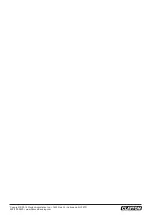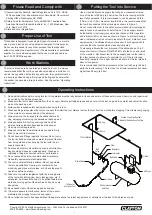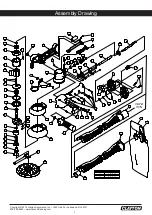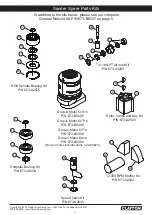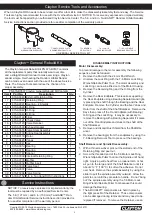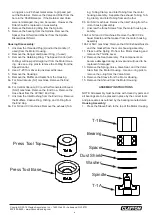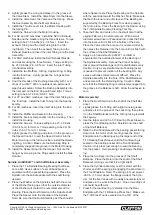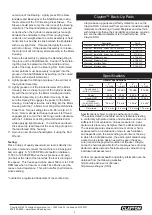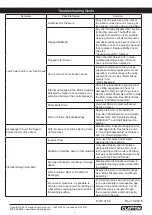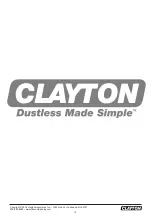
Copyright © 2016 Clayton Associates, Inc. • 1650 Oak St. • Lakewood, NJ 08701
800-248-8650 • www.VacuumSanding.com
1
Closed Loop Pipe System
Sloped in the direction of air flow
Drain Leg
Ball Valve
To Tool Station
Filter
Drain Valve
Regulator
Lubricator
Ball
Valve
Ball Valve
Air Flow
Air Dryer
Air Compressor
and Tank
Air Hose
To Coupler
at or near Tool
1) General Industry Safety & Health Regulations, Part 1910, OSHA
2206, available from: Superintendent of Documents; Government
Printing Office; Washington DC 20402
2) Safety Code for Portable Air Tools, ANSI B186.1 available from:
American National Standards Institute, Inc.; 1430 Broadway; New
York, New York 10018
3) State and Local Regulations.
This sander is designed for sanding all types of materials i.e. metals,
wood, stone, plastics, etc. using abrasive designed for this purpose.
Do not use this sander for any other purpose than that specified
without consulting the manufacturer or the manufacturer’s authorized
supplier. Do not use back-up pads that have a working speed less
than 12,000 RPM free speed.
The tool is intended to be operated as a hand held tool. It is always
recommended that the tool be used when standing on a solid floor. It
can be in any position but before any such use, the operator must be
in a secure position having a firm grip and footing and be aware that
the sander can develop a torque reaction. See the section “Operating
Instructions”.
Use a clean lubricated air supply that will give a measured air pres
-
sure at the tool of 90 psig (6.2 bar) when the tool is running with the
lever fully depressed. It is recommended to use an approved 3/8 in.
(10 mm) x 25 ft (8 m) maximum length airline. It is recommended that
the tool be connected to the air supply as shown in Figure 1.
Do not connect the tool to the airline system without incorporating an
easy to reach and operate air shut off valve. The air supply should
be lubricated. It is strongly recommended that an air filter, regulator
and lubricator (FRL) be used as shown in Figure 1 as this will supply
clean, lubricated air at the correct pressure to the tool. Details of such
equipment can be obtained from your supplier. If such equipment is
not used then the tool should be manually lubricated
To manually lubricate the tool, disconnect the airline and put 2 to 3
drops of air tool oil (Clayton P/N 678-20451) into the hose end (inlet)
of the machine. Reconnect tool to the air supply and run tool slowly
for a few seconds to allow air to circulate the oil. If the tool is used
frequently, lubricate it on a daily basis or lubricate it if the tool starts to
slow or lose power.
It is recommended that the air pressure at the tool is 90 psig (6.2 bar)
while the tool is running. The tool can run at lower pressures but never
higher than 90 psig (6.2 bar).
1) Read all instructions before using this tool. All operators must be fully trained in its use and aware of these safety rules. All service and repair must
be carried out by trained personnel.
2) Make sure the tool is disconnected from the air supply. Select a suitable abrasive and secure it to the back-up pad. Be careful and center the abra
sive on the back-up pad.
3) Always wear required safety equipment when using this tool.
4) When sanding always place the tool on the work then start the tool. Always remove the tool from the work before stopping. This will prevent gouging
of the work due to excess speed of the abrasive.
5) Always remove the air supply to the sander before fit-
ting, adjusting or removing the abrasive or back-up pad.
6) Always adopt a firm footing and/or position and be
aware of torque reaction developed by the sander.
7) Use only correct spare parts.
8) Always ensure that the material to be sanded is firmly
fixed to prevent its movement.
9) Check hose and fittings regularly for wear. Do not carry
the tool by its hose; always be careful to prevent the tool
from being started when carrying the tool with the air
supply connected.
10) Dust can be highly combustible. Vacuum dust collection
bag should be cleaned or replaced daily. Cleaning or
replacing of bag also assures optimum performance.
11) Do not exceed maximum recommended air pressure.
Use safety equipment as recommended.
12) The tool is not electrically insulated. Do not use where
there is a possibility of coming into contact with live
electricity, gas pipes, water pipes, etc. Check the area of
operation before operation.
13) Take care to avoid entanglement with the moving parts
of the tool with clothing, ties, hair, cleaning rags, etc. If
entangled, it will cause the body to be pulled towards the
work and moving parts of the machine and can be very
dangerous.
14) Keep hands clear of the spinning pad during use.
15) If the tool appears to malfunction, remove from use im
-
mediately and arrange for service and repair.
16) Do not allow the tool to free speed without taking precautions to protect any persons or objects from the loss of the abrasive or pad.
Putting the Tool into Service
Operating Instructions
Please Read and Comply with
Proper Use of Tool
Work Stations


